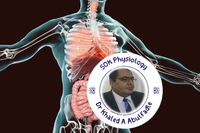| | Questions and Answers on GIT Physiology by Dr Khaled A Abulfadle |  |
|
|
| كاتب الموضوع | رسالة |
|---|
admin
Admin

عدد المساهمات : 9696
تاريخ التسجيل : 06/08/2009
 |  موضوع: Questions and Answers on GIT Physiology by Dr Khaled A Abulfadle موضوع: Questions and Answers on GIT Physiology by Dr Khaled A Abulfadle  الجمعة نوفمبر 09, 2012 5:14 am الجمعة نوفمبر 09, 2012 5:14 am | |
|
عدل سابقا من قبل Admin في الأحد يوليو 05, 2020 10:37 am عدل 4 مرات | |
|
  | |
admin
Admin

عدد المساهمات : 9696
تاريخ التسجيل : 06/08/2009
 |  موضوع: رد: Questions and Answers on GIT Physiology by Dr Khaled A Abulfadle موضوع: رد: Questions and Answers on GIT Physiology by Dr Khaled A Abulfadle  الجمعة نوفمبر 09, 2012 5:32 am الجمعة نوفمبر 09, 2012 5:32 am | |
| | |
|
  | |
admin
Admin

عدد المساهمات : 9696
تاريخ التسجيل : 06/08/2009
 |  موضوع: رد: Questions and Answers on GIT Physiology by Dr Khaled A Abulfadle موضوع: رد: Questions and Answers on GIT Physiology by Dr Khaled A Abulfadle  الجمعة نوفمبر 09, 2012 6:04 am الجمعة نوفمبر 09, 2012 6:04 am | |
| | |
|
  | |
admin
Admin

عدد المساهمات : 9696
تاريخ التسجيل : 06/08/2009
 |  موضوع: رد: Questions and Answers on GIT Physiology by Dr Khaled A Abulfadle موضوع: رد: Questions and Answers on GIT Physiology by Dr Khaled A Abulfadle  السبت نوفمبر 10, 2012 5:40 am السبت نوفمبر 10, 2012 5:40 am | |
| | |
|
  | |
admin
Admin

عدد المساهمات : 9696
تاريخ التسجيل : 06/08/2009
 |  موضوع: رد: Questions and Answers on GIT Physiology by Dr Khaled A Abulfadle موضوع: رد: Questions and Answers on GIT Physiology by Dr Khaled A Abulfadle  الأربعاء أكتوبر 08, 2014 9:31 am الأربعاء أكتوبر 08, 2014 9:31 am | |
| | |
|
  | |
admin
Admin

عدد المساهمات : 9696
تاريخ التسجيل : 06/08/2009
 |  موضوع: رد: Questions and Answers on GIT Physiology by Dr Khaled A Abulfadle موضوع: رد: Questions and Answers on GIT Physiology by Dr Khaled A Abulfadle  الأربعاء أكتوبر 08, 2014 11:25 am الأربعاء أكتوبر 08, 2014 11:25 am | |
| | |
|
  | |
admin
Admin

عدد المساهمات : 9696
تاريخ التسجيل : 06/08/2009
 |  موضوع: رد: Questions and Answers on GIT Physiology by Dr Khaled A Abulfadle موضوع: رد: Questions and Answers on GIT Physiology by Dr Khaled A Abulfadle  الخميس مايو 04, 2017 8:46 am الخميس مايو 04, 2017 8:46 am | |
| | |
|
  | |
admin
Admin

عدد المساهمات : 9696
تاريخ التسجيل : 06/08/2009
 |  موضوع: رد: Questions and Answers on GIT Physiology by Dr Khaled A Abulfadle موضوع: رد: Questions and Answers on GIT Physiology by Dr Khaled A Abulfadle  السبت أغسطس 26, 2017 10:02 am السبت أغسطس 26, 2017 10:02 am | |
| | |
|
  | |
admin
Admin

عدد المساهمات : 9696
تاريخ التسجيل : 06/08/2009
 |  موضوع: رد: Questions and Answers on GIT Physiology by Dr Khaled A Abulfadle موضوع: رد: Questions and Answers on GIT Physiology by Dr Khaled A Abulfadle  الأحد أغسطس 27, 2017 9:02 pm الأحد أغسطس 27, 2017 9:02 pm | |
| Q: Differences between upper and lower esophageal sphincters
========
Answer
Upper Esophageal Sphincter (UES) is an anatomic sphincter. The main functions of UES closure are to prevent esophageal air insufflation during negative intrathoracic pressure events, for example, inspiration, and to prevent esophagopharyngeal/laryngeal reflux during esophageal peristalsis. The UES is opened intermittently by relaxation of its sphincteric muscles, contraction of its distracting muscles, and bolus pulsion. The function of intermittent UES opening is to allow transphincteric flow of fluid or gas during orthograde events, for example, swallowing, or antegrade events, for example, emesis
Lower Esophageal Sphincter (LES) is a physiologic sphincter
It is an anti-reflux barrier prevents reflux of gastric contents into the esophagus, and its dysfunction leads to gastroesophageal reflux disease and or dysphagiA. It maintains tonic closure of the sphincter and relaxes upon swallowing. The LES is composed of smooth muscles, and it maintains tonic contraction owing to myogenic as well as neurogenic factors. It relaxes due to vagally mediated inhibition involving nitric oxide as a neurotransmitter
         | |
|
  | |
admin
Admin

عدد المساهمات : 9696
تاريخ التسجيل : 06/08/2009
 |  موضوع: رد: Questions and Answers on GIT Physiology by Dr Khaled A Abulfadle موضوع: رد: Questions and Answers on GIT Physiology by Dr Khaled A Abulfadle  السبت مايو 05, 2018 11:39 pm السبت مايو 05, 2018 11:39 pm | |
| | |
|
  | |
admin
Admin

عدد المساهمات : 9696
تاريخ التسجيل : 06/08/2009
 |  موضوع: رد: Questions and Answers on GIT Physiology by Dr Khaled A Abulfadle موضوع: رد: Questions and Answers on GIT Physiology by Dr Khaled A Abulfadle  الأحد أغسطس 05, 2018 10:01 pm الأحد أغسطس 05, 2018 10:01 pm | |
| | |
|
  | |
admin
Admin

عدد المساهمات : 9696
تاريخ التسجيل : 06/08/2009
 |  موضوع: رد: Questions and Answers on GIT Physiology by Dr Khaled A Abulfadle موضوع: رد: Questions and Answers on GIT Physiology by Dr Khaled A Abulfadle  الأحد يوليو 05, 2020 10:26 am الأحد يوليو 05, 2020 10:26 am | |
| | |
|
  | |
| | Questions and Answers on GIT Physiology by Dr Khaled A Abulfadle |  |
|
